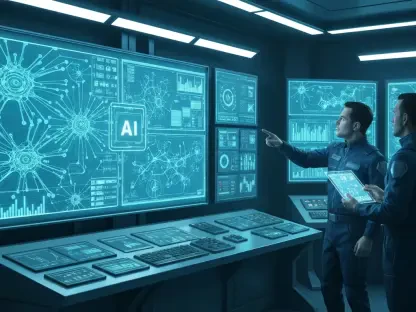In an era where manufacturing efficiency can make or break industries, a groundbreaking partnership between NEC, a titan of Japanese technology, and Siemens, a German engineering powerhouse, is poised to redefine the landscape of industrial robotics with innovative solutions. This collaboration targets a persistent hurdle in factory automation: the labor-intensive and expensive process of manually programming robots to perform tasks. By harnessing the potential of artificial intelligence (AI), these two global leaders aim to streamline how robots are taught, slashing setup times and reducing reliance on specialized human expertise. Their combined innovation promises not just technical advancement but a seismic shift in how factories operate, potentially impacting sectors from automotive to electronics. As competition in the robotics field intensifies across continents, this alliance stands out as a strategic move to secure a foothold in a rapidly evolving market, sparking curiosity about how it will reshape global manufacturing dynamics.
The Power of AI in Robot Teaching
Automating the Learning Process
The core of the NEC-Siemens partnership lies in a transformative approach to robot programming, moving away from the traditional, hands-on method of teaching robots through manual input. By integrating NEC’s Robot Task Planning software, a key component of its BluStellar initiative, with Siemens’ Process Simulate software from the Tecnomatix portfolio, the collaboration creates a system where AI automates the generation of robot motion plans. This synergy allows robots to learn tasks through data-driven algorithms and 3D simulations, eliminating much of the time and cost associated with human intervention. The result is a faster, more adaptable process that can be implemented across diverse production environments, addressing a critical pain point for manufacturers who often struggle with lengthy setup periods. This technological leap forward signals a future where automation isn’t just about performing tasks but about learning them efficiently and independently.
Beyond the technical integration, this AI-driven solution tackles the scalability challenges that have long plagued industrial robotics. Manual teaching requires skilled engineers to painstakingly program each robot for specific tasks, a process that becomes exponentially more complex as production demands grow. The NEC-Siemens system, however, uses advanced algorithms to analyze tasks and simulate optimal movements, ensuring robots can adapt to new instructions with minimal human oversight. This not only reduces the burden on technical staff but also democratizes access to automation technology, making it feasible for smaller manufacturers to adopt sophisticated robotics without prohibitive costs. As factories face increasing pressure to pivot quickly in response to market shifts, this automated teaching method offers a lifeline, enabling rapid reconfiguration of production lines to meet evolving needs without sacrificing precision or efficiency.
Benefits for Manufacturing Efficiency
The operational advantages of AI-driven robot teaching are poised to revolutionize manufacturing workflows on a global scale. One of the most immediate benefits is the drastic reduction in setup times for production lines, as robots can now be programmed automatically rather than through tedious manual processes. This efficiency translates into significant cost savings, particularly for industries like automotive and electronics, where downtime can lead to substantial financial losses. Moreover, the precision offered by AI-generated motion plans optimizes cycle times, ensuring robots perform tasks at peak performance without unnecessary delays or errors. Manufacturers stand to gain a competitive edge by streamlining operations, allowing them to allocate resources more effectively and focus on innovation rather than repetitive programming tasks. This shift could redefine productivity standards across sectors reliant on automation.
Additionally, the broader impact of this technology lies in its ability to enhance adaptability within factories. In a world where consumer demands change rapidly, the flexibility to retool production lines swiftly is invaluable. The NEC-Siemens solution enables robots to learn new tasks through simulations and data analysis, meaning manufacturers can pivot to new products or processes without the weeks-long delays typically associated with reprogramming. This agility not only boosts output but also reduces waste, as optimized robot movements minimize energy consumption and material errors. Furthermore, by lessening the dependency on highly specialized engineers, the system lowers the barrier to entry for companies looking to integrate robotics into their operations. As industries grapple with labor shortages and rising costs, this innovation offers a sustainable path forward, promising to reshape how factories balance efficiency with economic viability.
Global Competitiveness and Strategic Positioning
Japanese-German Alliance as a Market Advantage
The strategic alliance between NEC and Siemens represents a formidable blend of Japanese precision and German engineering prowess, positioning them as significant players in the global robotics arena. Unlike some of their competitors, these companies face no operational restrictions in the world’s two largest economies, the United States and China, granting them unparalleled access to critical markets. This freedom allows for seamless deployment of their AI-driven solutions across diverse regions, amplifying their influence in an industry where geopolitical barriers often hinder progress. By combining their respective strengths, NEC and Siemens are not merely innovating but also carving out a competitive niche that challenges the dominance of other global tech giants. This partnership underscores a deliberate effort to bolster the presence of Japanese and German technology in manufacturing, countering the approaches of American and Chinese counterparts with a focus on collaborative excellence.
Furthermore, this collaboration serves as a counterweight to the intensifying rivalry in industrial automation, where regional strengths often dictate market success. The fusion of NEC’s expertise in AI and data analytics with Siemens’ deep-rooted experience in industrial engineering creates a synergy that is hard to replicate. Their joint solution is tailored to meet the nuanced demands of modern manufacturing, where precision and reliability are paramount. This alliance also benefits from a shared cultural emphasis on meticulous craftsmanship, which translates into technology that prioritizes quality over sheer volume. As global supply chains become increasingly complex, the ability to operate without hindrance in key economic hubs offers a logistical advantage, enabling faster adoption of their innovations. This strategic positioning could redefine market dynamics, setting a benchmark for how cross-border partnerships can drive technological progress in robotics.
Diverse Applications and Business Growth
NEC’s BluStellar initiative, which underpins the Robot Task Planning software, extends far beyond the realm of robotics, serving as a multi-domain AI platform that enhances efficiency across industries like telecommunications, aviation, and healthcare. With a reported annual growth rate of 20%, BluStellar is a pivotal driver of NEC’s business expansion, contributing significantly to both sales and profitability. This broad applicability underscores the versatility of NEC’s technological framework, positioning the company as a leader in leveraging AI for diverse operational challenges. The partnership with Siemens amplifies this impact by integrating BluStellar’s capabilities into a wider industrial context, ensuring that the benefits of AI-driven automation reach a global audience. This collaboration is not just a technical milestone but a cornerstone of NEC’s strategy to diversify and strengthen its market presence through innovative solutions.
Siemens, as Europe’s largest engineering firm, brings its own robust portfolio to the table, with expertise spanning Digital Industries, Smart Infrastructure, and Mobility sectors. The company’s focus on industrial automation and infrastructure complements NEC’s AI innovations, creating a comprehensive approach to modern manufacturing challenges. Through joint marketing efforts such as seminars and exhibitions, the partnership aims to accelerate the adoption of their combined solution, targeting industries eager to embrace automation for competitive advantage. Siemens’ established reputation in engineering excellence enhances the credibility of this collaboration, ensuring that their AI-driven robot teaching technology is seen as a trusted solution. Together, these companies are not only advancing robotics but also reinforcing their respective positions as indispensable players in the global tech ecosystem, driving growth through strategic alignment and shared vision for a more automated future.
Challenges in the Industrial Robotics Landscape
Rivalry Among Industry Giants
The industrial robotics market is a battleground of innovation, with major players like ABB, Fanuc, Yaskawa, and Nvidia pushing the boundaries of what automation can achieve. Nvidia, in particular, stands out with its Isaac Sim platform, which integrates advanced AI and simulation capabilities to enable real-time decision-making for robots. Supported by partnerships with prominent manufacturers, Nvidia’s technology represents a significant challenge to the NEC-Siemens collaboration, as it offers a comprehensive ecosystem for robotic development. Additionally, other competitors, including smaller firms and open-source platforms like Gazebo and Webots, provide accessible alternatives for manufacturers seeking cost-effective simulation and programming tools. This crowded field highlights the urgency for continuous innovation, as companies vie to capture market share in an industry where technological superiority can swiftly alter competitive standings.
Beyond the heavyweights, the diversity of solutions in the robotics space adds another layer of complexity to the market. Companies like RoboDK from Canada and Coppelia Robotics from Switzerland offer specialized simulation and calibration services that cater to niche needs, appealing to manufacturers with specific requirements. Meanwhile, the availability of open-source tools democratizes access to robotics technology, allowing even small-scale operations to experiment with automation without significant investment. This fragmented landscape means that NEC and Siemens must differentiate their AI-driven solution not just through technical prowess but also through ease of integration and scalability. As the industry evolves, the ability to adapt to varied customer demands and outpace rivals in delivering cutting-edge features will be crucial. The intense rivalry among these players underscores the high stakes of innovation in robotics, where staying ahead requires relentless focus and strategic foresight.
China’s Push for Technological Independence
China, as the world’s largest industrial economy, holds a commanding position in the deployment of industrial robots, outpacing other nations in sheer volume. However, despite this dominance, the country still relies heavily on Japanese and European technology for high-end applications, particularly in sectors like automotive manufacturing where precision is critical. This dependency has spurred a national drive toward technological self-reliance, with Chinese companies such as Siasun, Estun Automation, and Inovance making significant strides to increase their domestic market share to nearly 40%. The push to reduce reliance on foreign tech is fueled by a broader goal of maintaining export competitiveness, positioning China as a formidable force in the robotics landscape. This dynamic adds pressure on partnerships like NEC-Siemens to maintain their edge in innovation and market access.
In parallel, China’s aggressive investment in AI-driven robotics reflects a strategic focus on closing the gap in high-end applications. Innovations such as Huawei’s Cloud Pangu Model Robot Suite and emerging ventures like Mech-Mind Robotics demonstrate the country’s commitment to advancing up the value chain. These developments are often backed by substantial government support, aiming to build a robust domestic ecosystem that can rival global leaders. While still trailing in certain technical domains, Chinese firms are rapidly gaining ground, particularly in scalable production and cost efficiency. The NEC-Siemens collaboration serves as a reminder of the competitive stakes at play, highlighting the need for continuous advancement to counter China’s growing capabilities. As this race intensifies, the balance between collaboration and competition in the global robotics market will likely shape the future of manufacturing on an international scale.
United States’ Industrial Decline
Across the Atlantic, the United States grapples with a concerning decline in its industrial infrastructure, despite holding a leadership position in AI through companies like Nvidia. While Nvidia’s advancements in simulation and robotics technology set a high bar, the broader atrophy of American manufacturing capabilities poses a significant risk to long-term competitiveness. This erosion of industrial strength stands in stark contrast to the rapid advancements seen in regions like Asia and Europe, where investments in automation and infrastructure remain robust. The NEC-Siemens partnership could act as a catalyst, prompting a reevaluation of priorities within the U.S. to prevent further slippage in a sector critical to economic vitality. The disparity between technological innovation and industrial decline presents a complex challenge that demands urgent attention from policymakers and industry leaders alike.
Moreover, the implications of this decline extend beyond domestic borders, affecting global supply chains and economic influence. As manufacturing hubs shift to other regions, the U.S. risks losing ground in setting industry standards and driving innovation in robotics. The NEC-Siemens alliance, with its focus on AI-driven automation, underscores the potential for technology to revitalize industrial sectors if leveraged effectively. For the U.S., the challenge lies in rebuilding a manufacturing base that can integrate cutting-edge solutions while addressing systemic issues like workforce training and infrastructure investment. Without a concerted effort to reverse this trend, the gap between American AI prowess and industrial capacity may widen, diminishing its ability to compete with unified strategies seen in partnerships like the one between NEC and Siemens. This scenario highlights the broader stakes of maintaining a balanced approach to technological and industrial progress.
Reflecting on a Transformative Partnership
Looking back, the alliance between NEC and Siemens marked a pivotal moment in the evolution of industrial robotics, as it successfully challenged the inefficiencies of manual robot teaching with a sophisticated AI-driven alternative. Their integration of advanced software tools demonstrated how strategic collaborations could address longstanding bottlenecks in manufacturing. This partnership not only elevated the competitive standing of Japanese and German technology but also set a precedent for how cross-border innovation could counterbalance the approaches of other global powers. As the industry reflected on this achievement, it became clear that the fusion of precision and engineering excellence had laid a foundation for future advancements in automation. Moving forward, the focus should shift to scaling these solutions across diverse sectors, ensuring accessibility for manufacturers of all sizes, and fostering policies that support sustained investment in robotics. The next steps involve exploring how such technologies can adapt to emerging challenges, paving the way for a smarter, more resilient industrial landscape.









